Day 73: Traveling between Chimney Rock and Great Sand Dunes National Park, we paused to hike a short section of the Continental Divide Trail at Wolf Creek Pass. A wide variety of wildflowers were in bloom.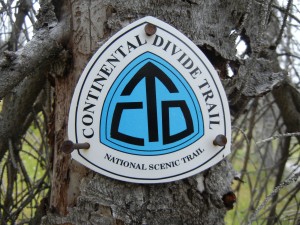
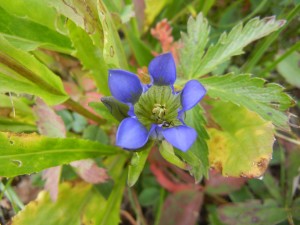
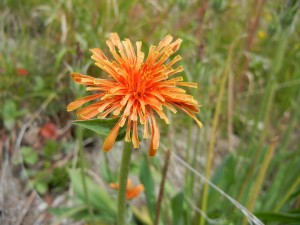
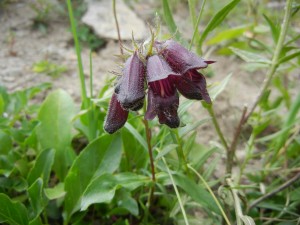
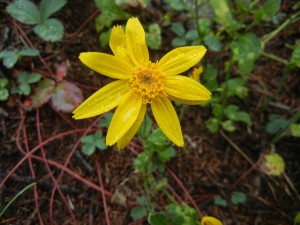
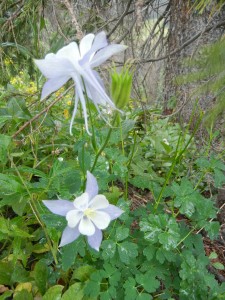
Day 74: To us New Englanders, the dunes in Great Sand Dunes National Park look really big (they are the tallest dunes in North America, about 750 feet tall).
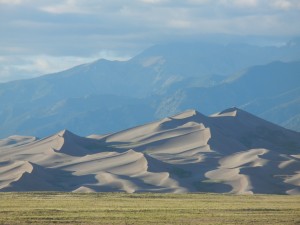
This impressive dune field is nestled against the western slope of the Sangre de Cristo mountain range in southern Colorado, and the local patterns of wind and water erosion work together to maintain the dramatic size and shape of these sand dunes and keep them from washing or blowing away. At favorable water levels, particularly in the spring, Medano Creek between the dunes and the mountains is known for its surging flow (caused by build-up and collapse of sand ridges on the bottom). The flow was too low to see surging when we were there, but we did enjoy watching the intricate and constantly changing ripple patterns.
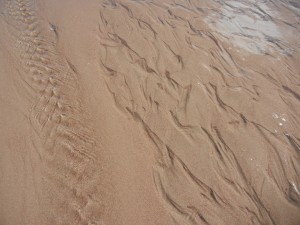
There are no established trails in the dune field; hikers are simply encouraged to explore wherever they please.
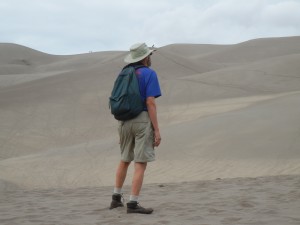
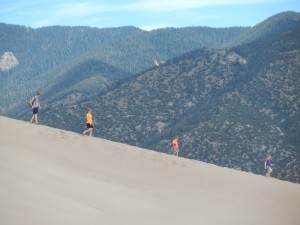
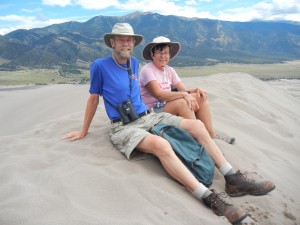
Though the dunes are mostly bare, shifting sand, there are some vegetated pockets between them. The prairie sunflowers were especially beautiful.
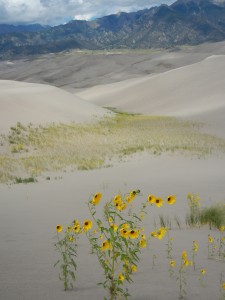
We also hiked to Zapata Falls, which plummets over a 30-foot precipice inside a slot canyon. To view the falls one has to hike up the stream bed between the twisting canyon walls.
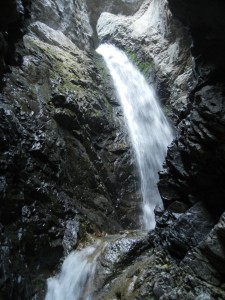
Days 75-80: Northbound through Colorado Springs, we stopped to see the Garden of the Gods, a city park featuring a dramatic cluster of reddish sandstone pinnacles and slabs.
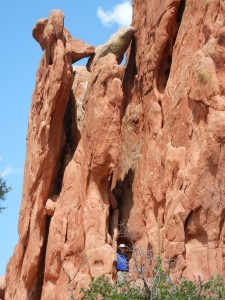
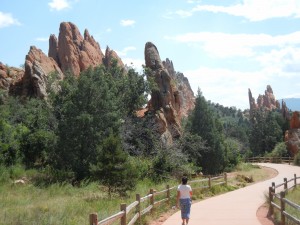
Traveling through Colorado gave us our first chance to visit Lowy and Kyle in their new home in Frederick, which they bought soon after their wedding last October. Some highlights of our visit were biking on the St. Vrain Greenway and around Kyle’s hometown of Longmont, a family barbecue hosted by Lowry and Kyle for us and the Graba clan, side excursions to Rocky Mountain National Park and a special exhibit at the Denver Botanical Garden, a visit with Kyle’s parents Jim and Cheryl, and a local chainsaw sculpture competition. At Rocky Mountain we saw lots of elk and went on a couple of hikes.
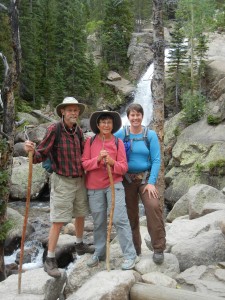
The botanical garden is always a pleasant and interesting place to stroll through, and the visiting exhibit of bronze horse sculptures was very impressive. Each original sculpture was built up from various pieces of wood, the pieces were removed and individually cast, molten bronze was poured into the molds, the cooled bronze parts were welded together in the original configuration, and the surface was painted to resemble the original wood.
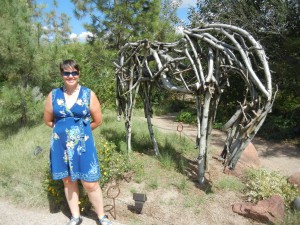
Day 81: Our drive eastward through Nebraska cornfields was pretty monotonous, but we did find a nice campground and bike ride at Johnson Lake. The 12-mile loop around the lake was at least half on a paved bike path with the rest on quiet country roads. The campsites were scattered under big old cottonwood trees, and a swim at the beach after our ride was very refreshing.
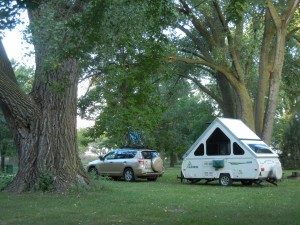
Day 82: After more vistas of cornfields, we managed to find another decent campsite (we didn’t have reservations and it was the middle of Labor Day weekend). Then we visited Homestead National Monument on the site of the first homestead claim after the law went into effect in January 1863. Land grants were made under the Homestead Act in most of the states outside of the original 13 colonies, and the acreage was considerable, particularly in states like Oklahoma, Colorado, Wyoming, and Montana. The National Monument has a nice visitor center, one of the early homesteader cabins that was moved from nearby and restored, and walking trails around and through a big field restored to contain the kinds of prairie grasses and other plants seen by the original homesteaders.
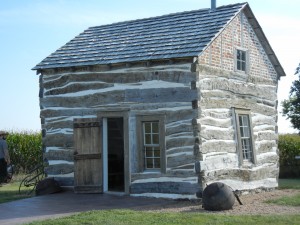
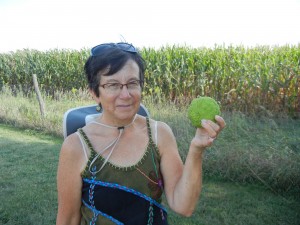
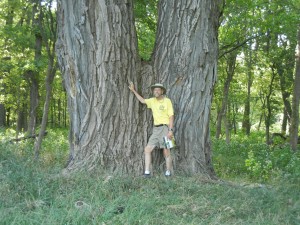
Day 83: On our way out of Nebraska we stopped for a hike in Platte River State Park. The Platte is the dominant geographic feature of Nebraska, and its valley was followed by the wagon trains heading west in the 1840s and 1850s. Our hiking trail meandered around a lot and was too deep in the woods for a clear view of the river, but there were nice tall deciduous trees such as oaks and walnuts. After the hike we had a good view of the river from a 10-story tower at the park, from which on a clear day one can see where nearly half of all Nebraskans live.
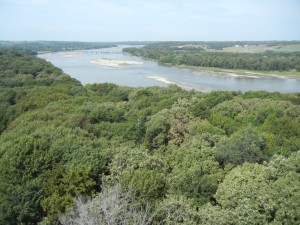
Days 84-85: Visiting and biking were on the agenda as we headed up into southern Minnesota to visit Ann & Gary in St. Paul. In the two months since we had seen them in Duluth on the westbound leg of our trip, they had been to Iceland and Switzerland, so we were eager to hear of each other’s vacation travels. The next day they led us on a scenic bike ride across the Mississippi, into Minneapolis, along a bike path in the greenway beside Minnehaha Creek, around Lake Nocomis, down along the Minnesota River, and to a charming restaurant for a gourmet lunch.
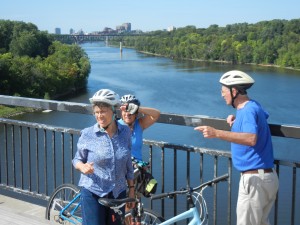
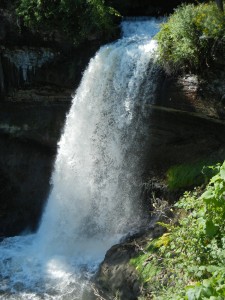
Days 86-87: On to North Mankato to visit Jack & Nancy, whom we hadn’t seen for about 10 years—we’ve known them since Jack spent a sabbatical semester at the UNH Chemistry Department about 20 years ago. Although they are about 11-12 years older than we are, they haven’t slowed down much in retirement. They took us on a bike ride of about 20 miles on the Red Jacket Trail and otherwise royally entertained us even though they were in the midst of preparing to leave in a couple of days on a three-week trip to several eastern European countries.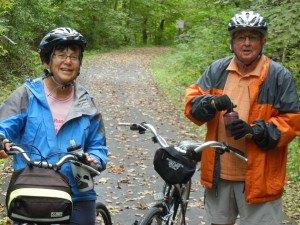
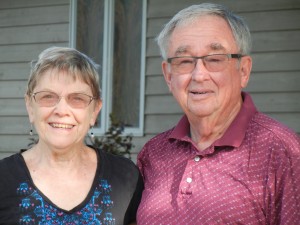
Day 88: Ledges State Park was our first stop in Iowa. In this region of boringly flat farmland, you would hardly guess that this patch of woodland hides a steep-walled creek canyon winding between sandstone cliffs.
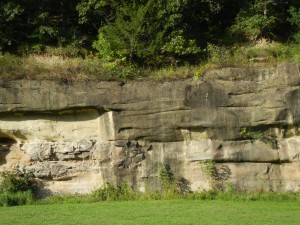
It was an adventure to drive the one-way park road down into the canyon where it crosses the creek multiple times by way of shallow concrete fords lined with steppingstones. The water level is high enough about half of the time so that the park road has to be closed to traffic. The hiking trails we explored were short but steep, up and down the slopes and along cliff rims.
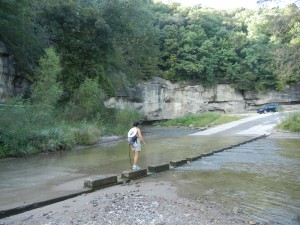
Day 89: We had a very pleasant Iowa bike ride, a little northeast of Des Moines. We rode 10.8 miles each way out and back on the paved Chichaqua Valley rail trail, which is mostly wooded, passes or crosses several small creeks and wetlands, has some views across fields and pastures, and crosses the South Skunk River on a long trestle. For lunch we joined a cyclist at a trailhead picnic shelter and shared traveling, hiking, and biking experiences—we had hiked some of the same trails in Glacier National Park—and he told us of some of the interesting local places.
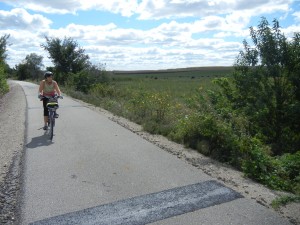
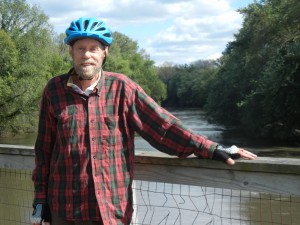
Day 90: We hadn’t seen our nephew Tyler more than once or twice since he moved to Iowa several years ago, so it was great to be able to visit him, his wife Nicole, and their one-and-a-half-year-old son Connor for the day. They took us to see Maquoketa Caves, a state park with walking trails through an extensive cave system. We stuck mostly to the trails through the large caverns with full headroom, but there are also passages that can be explored by those who don’t mind crawling through small openings.

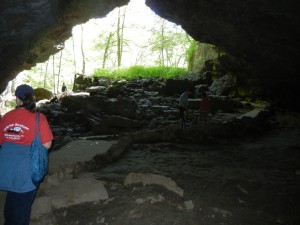
Day 91: We arrived at Turkey Run State Park with enough time before dark for a three-hour exploration of part of the park’s rugged and beautiful hiking trail network. Trails wind through dramatic canyons, with jagged sandstone walls and overhangs.
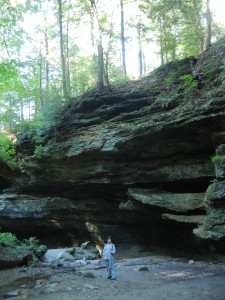
The coolness and moisture in these canyons harbor an ecosystem usually found only much farther north. The surrounding woods have many towering old-growth hardwoods, such as tulip trees, black walnuts, beech, and oak, whose broad trunks are very straight and tall. The very wide tulip tree logs used in the old cabin preserved at the park attest to the stately size of the trees found by the American pioneers.
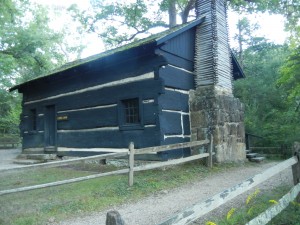
Day 92: We had the Farm Heritage Rail Trail mostly to ourselves on a beautiful late summer afternoon, with a cool breeze and a few crunchy leaves under our bike tires. The trail is very straight and lined with deciduous trees, with farmland along either side. There is a nice art gallery where we accessed the trail in Thorntown.
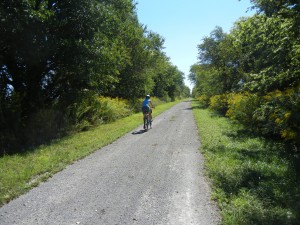
Day 93: Today we visited with all of Amy’s Johnson relatives: Doug & Casey, Ed & MeiZhen, Merrillyn, and Uncle Merrill & Aunt Irene. Butterfly enthusiast Doug led us on a walk through some of the trails he has developed in the 25-acres of woods behind their house, pointing out not only several butterfly species, but also a wide variety of local plants that were unfamiliar to us New Englanders.
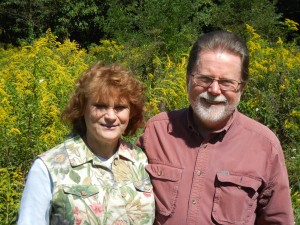
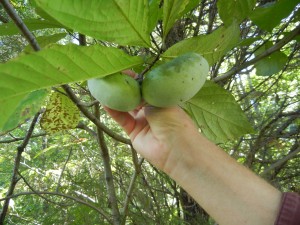
Ed & MeiZhen (“Amy”) entertained us with descriptions and pictures of their recent trip to Hawaii and some tasty Chinese home cooking. Walking around their lovely neighborhood it was sad to see that all of the beautiful old ash trees are dying and have to be cut down because of the emerald ash borer infestation.
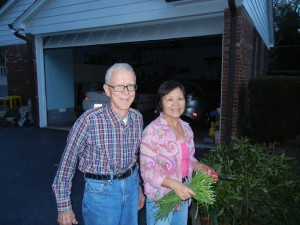
Days 94-95: We missed doing a bike ride in Michigan on the westward leg of our trip, so we detoured north between visits in Indiana and Ohio to camp in Van Buren State Park, just south of the resort town of South Haven. We strolled on the beach and swim in Lake Michigan on both days. There were tall sand dunes stabilized by a healthy beach plant community and hardwood forest, fine-grained sand on the beach, and very smooth stones in the surf zone. For our bike ride, we explored two rail trails connected by paved bike paths and bike lanes through South Haven, where we discovered a high-end ice cream shop with some great flavors.
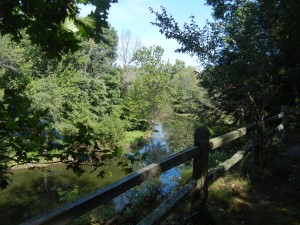
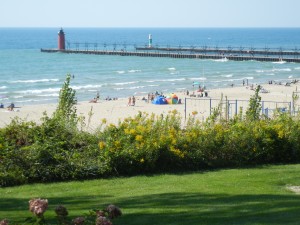
Days 96-99: In central Ohio, visiting Amy’s cousin Jan and her husband Larry, we also got to visit with Jan’s sister (Joyce), her brothers (Jim and John), her mom (Amy’s Aunt Wava), her daughters (Jalena and Dawnel), and two of her grandchildren (Evelyn and Tristan).
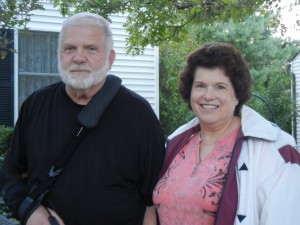
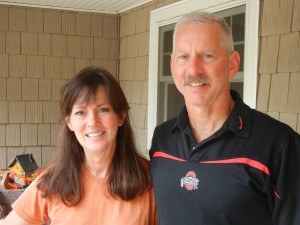


Day 98: A short distance north of Jan’s, we visited Lisa and Lisle. Lisa is a former Normandeau colleague of Paul’s from the early 1980s. They took us for a hike on the trails of a nearby county park, Lisa showed us around Ohio Wesleyan U where she is a biology lab supervisor, and we relaxed while trying to catch up on each other’s lives since the last time we saw them when they lived in Ontario some 20 years ago.
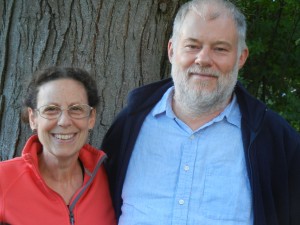
Day 99: In southeastern Ohio we began seeing more hills and woods than we had seen for a long time. We hiked the short (5-mile) loop of the Wildcat Hollow Trail, gradually ascending onto a ridge above the hollow and back down through another creek valley. These woods were mostly hardwoods (oaks, black walnuts, sycamores, hickories, maples, beech, etc.) and fairly open with little undergrowth. In addition to black walnuts, we found occasional husks of yellow buckeye nuts on the ground (a tree new to us). The trail passed the decrepit hulk of a one-room schoolhouse, but there wasn’t any indication of how along ago it was abandoned.
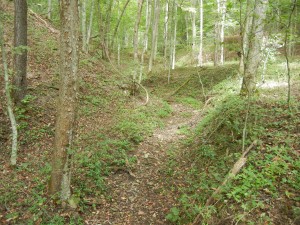
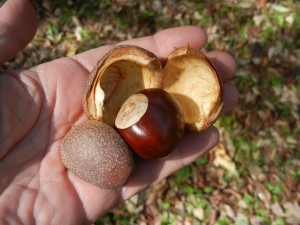
Days 100-101: As we drove farther and farther east of the Ohio River, we could appreciate why West Virginians call their land the Mountain State. Long mountain ridges are steep-sided and separated only by narrow stream valleys. Many of the streams are called runs, with the roads named after them (White’s Run Road, Dog Run Road, and so on). Mountains and forest predominate here, not the flat farmland we had been seeing in the Midwest. We biked about 14 miles north from Elkins and back again on the Allegheny Highlands rail trail. It goes through quiet countryside, along slow streams, past rural homes and small farms, and gently climbs over a ridge in the shadow of tall rhododendrons. The weather was perfect for a bike ride—bringing the song “Country Roads” to mind as we rolled along.
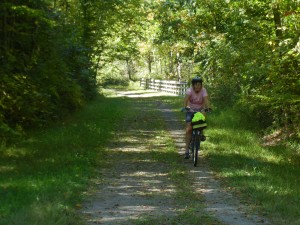
Day 102: We camped near Seneca Rocks, a prominent rock formation popular with rock climbers and tourists.
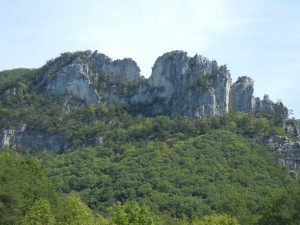
Since we had last been there (in 1982) the U.S. Forest Service has built a nice new visitor center and a campground. The specific location of the visitor center was relocated to avoid disturbing an area containing Native American artifacts thousands of years old. There is a nice archaeology exhibit in the visitor center. We hiked into the forest on the Allegheny Mountain Trail, which ascends by gentle switchbacks to the crest of a long ridge and then follows the sharp ridgetop for several miles. We were hiking through fairly open forest (mainly hardwoods, with occasional rock ledges, mountain laurel, and rhododendrons), with partial views of the adjacent mountain ridges to either side.
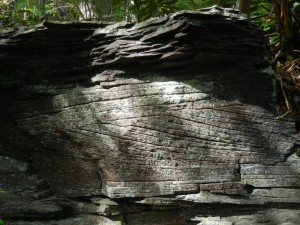
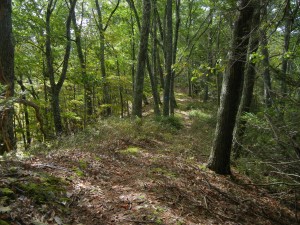
Some 90% of West Virginia’s trees were clearcut back in the late 1800s and early 1900s, resulting in extensive forest fires and erosion, but since the replanting efforts in the 1930s, the forests have recovered nicely. We would like to return to the Monongahela National Forest and spend more time exploring the many hiking trails.